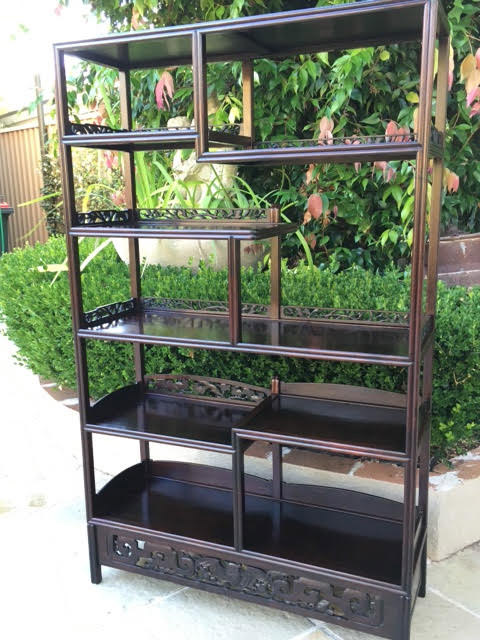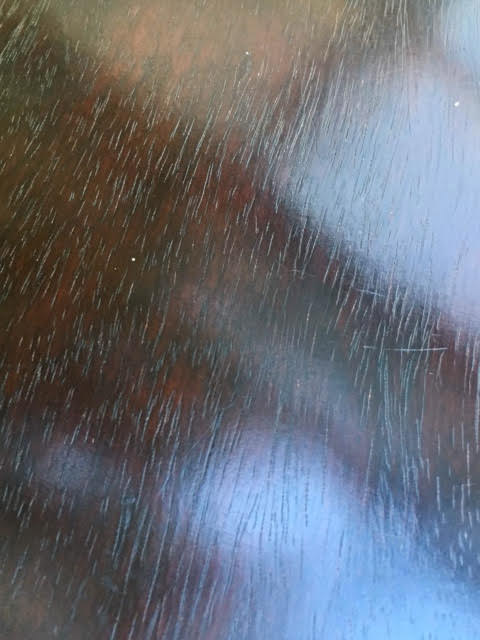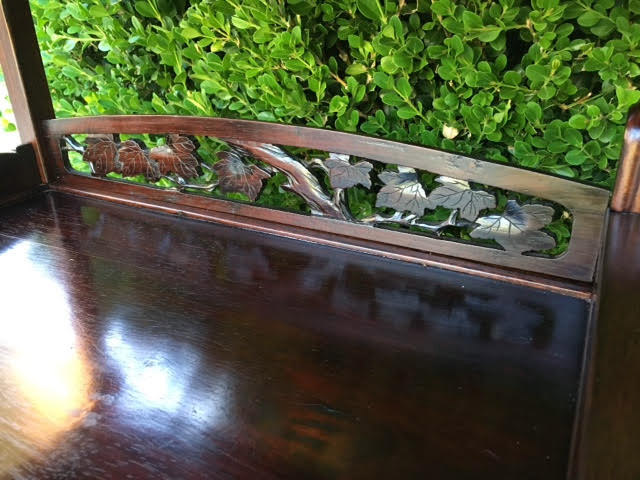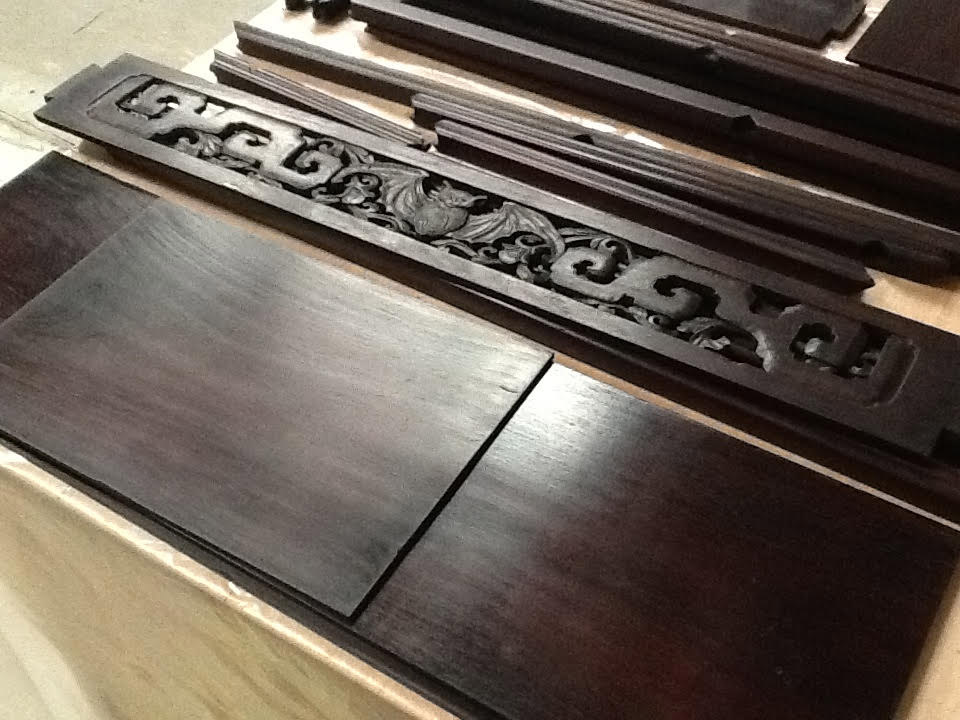
|
Subject:Re: Zitan and Hongmu Cabinet
Posted By: Kirk Sun, Apr 10, 2016
Hi Mark,
Nice thing, good find!
Pierced floral gallery & bat motif usually associated with late Qing (19thC) but not unanimously. Desirable item though either way.
Zitan? Not totally impossible. You should know however that both hongmu & zitan have SG range above 0:00, so the sink test is not as reliable as you may think in deciding whether something's zitan, or not zitan. Huanghuali has the same characteristics, it also sinks; as does huali; laohuali; wumu; teilimu; certain varieties of huamu; and of course the prized semi fossilised pith wood of nanmu (ddly however the balance of the nanmu tree does not react in the same way) So I wouldn't jump the gun there if I were you.
I'm not sure what you're talking about, re: 'unmistakable hog hair grain & smell'. if it had a pleasent smell, similar to incense, chances are significantly high it's the so called 'Dalbergia odorifera', or huali wood, which would be great for you if it was. Certainly better than if it's hongmu, which has a pungent smell.
Less great though, admittedly, as if it is in fact zitan. (there is at any rate no way of telling if it is by looking at these shots, so the verdict's still out in my book)
Something else you should know before coming to any conclusion on whether a wood is zitan or not (apart from a vast array of botanic & other acadmic literature on the topic) is, for your benefit, and possibly the benefit of other students and enthusiasts of the Chinese hardwoods who read these posts, a short check list of characteristics & further considerations:
"A Mirky Subject" (ref: L Sickman) de-fogging mind app.
Zitan is a well documented Chinese medicinal plant, that we find first reference to in Chi Bao's 3rd century 'Gu jiu Zhu'. It is thus one species only, botanic name Pterocarpus santalinus, which only grows on substrates of 20% shale and 80% quartzite in pockets that form an an alluvial fan along the Himmalayan foothills. The proto South China Sea bed (the triassic tethys in other words) and nowhere else. Few other trees thrive on these shale substrates, and consequently where sanders is found it dominates and is only found in forests. When the root encounters shale, a survival mechanism causes side shoots to grow from the trunk, which produces it's distinctive chatoyancy. All zitan displays at least 20% chatoyancy, and most components display significantly more. The species (sp) further, has a tendancy to rot from the inside, and large beetle caverns are often found on the secondary components of pieces of furniture made of this sp. Accordingly, individual components are very rarely, very wide.
It's important to remember that 34 hardwood sp were identified in a study @ Beijing agricultural circa 2002, as having been used in Chinese furniture during the Ming & Qing dynasties. It's also important to remember this study may not be complete, and does not take extinct sp into account. We are aware for example that Yunnan Zitan was over exploited during Qianlong's reign, and that there are other Ming & Qing texts, relating to sp extinction.
A range of Dalbergia; Pterocarpus; Ormoisa; Cassia; Dyospyros & other genera sp were used in Chinese furniture (but as an example there are over 200 Dalbergia genera sp worldwide) so the Chinese system of nomenclature as related to the hardwoods is not exactly what contemporaneously would be considered scientific, but there certainly are important distinctions you should familiarise yourself with if you have an interest in the Chinese hardwoods.
Wang Shixiang published some valuable notes on the topic but there is a growing view that these findings represent only a miniscule proportion of light through the murkiness, and are less conclusive than we had at first hoped.
Here's what we know for sure:
• All the species can be referred to as Hongmu, including Huali and Zitan.
• They are all very similar and difficult to tell apart, even with the benefit of an electron microscope.
• If you're not sure about the timber it's best to use the term hongmu.
• Jichimu; Teilimu; Nanmu; Rosewood; and Boxwood all have lower SG than 0:00, and will float in water.
• These are not called hongmu.
• The rest are very high density and will sink, including Wumu, (ebony) that was also used but is very rare.
• Some rare ebony sp, such as coromandel, were also used but are rare in the extreme.
• A few are called Laohuali; and a few are called Xinhuali.
• Only a very small number of the sp should be referred to as Huali wood, but certainly a fair range of species and sub species that are true palisanders, and were used and referred to as Huali wood by the Ming and Qing timbermerchants of Guangzhou, should be, and are called, huali.
• Huang is used as a prefix for well patinated Huali wood, and huanghuali is thus not, a wood species as such. (Shixiang's references are another matter, and will be left in the murkiness for the time being)
• Only one of the sp should be referred to as Zitan; being Pterocarpus santalinus (but this we already know; as does every Chinese traditional doctor; and did Su Gong; and all 22 scholars including Su Jing and Li Ji, when he published 'Tang Benecao' - a 53 volume illustrated pharmacopia - in 659AD.
It would serve you well to bear in mind these are connoisseurs terms that relate largely to grain & patina, and that there are not enough Chinese variations in the nomenclature to fill the diversity in range of species. If however these species were not used in China during the Ming & Qing dynasties, care should be taken never to use the Chinese hardwood terms in identification.
I hope this helps.
I do think it has potential and you should get someone who knows what they're looking at to view it - I would be happy to do so, but am based in London, and don't know where you're based.


|
 Zitan and Hongmu Cabinet
Zitan and Hongmu Cabinet  ( China & Japan ) - Mark Riley - Mar 01, 2016 (05:09 AM)
( China & Japan ) - Mark Riley - Mar 01, 2016 (05:09 AM)  Re: Zitan and Hongmu Cabinet
Re: Zitan and Hongmu Cabinet  - Mark Riley - Mar 01, 2016 (05:13 AM)
- Mark Riley - Mar 01, 2016 (05:13 AM)  Re: Zitan and Hongmu Cabinet - Kirk - Apr 10, 2016 (02:20 PM)
Re: Zitan and Hongmu Cabinet - Kirk - Apr 10, 2016 (02:20 PM)  Re: Zitan and Hongmu Cabinet - Mark Riley - Apr 13, 2016 (05:14 AM)
Re: Zitan and Hongmu Cabinet - Mark Riley - Apr 13, 2016 (05:14 AM)  Re: Zitan and Hongmu Cabinet - Tim - May 02, 2016 (09:16 AM)
Re: Zitan and Hongmu Cabinet - Tim - May 02, 2016 (09:16 AM)  Re: Zitan and Hongmu Cabinet - Mark Riley - May 03, 2016 (04:53 AM)
Re: Zitan and Hongmu Cabinet - Mark Riley - May 03, 2016 (04:53 AM)  Re: Zitan and Hongmu Cabinet - Mark Riley - May 03, 2016 (05:52 AM)
Re: Zitan and Hongmu Cabinet - Mark Riley - May 03, 2016 (05:52 AM) 




